Experimental Granulometric Characterization of Wood Particles from CNC Machining of Chipboard
Abstract
1. Introduction
2. Materials and Methods
2.1. CNC Machine
2.2. Tool Parameters
2.3. Milling Wood Samples
- DistPx—distance between the selected points in pixels;
- X1, Y1—coordinates of the first selected point;
- X2, Y2—coordinates of the second selected point.
- Con. Coef—conversion coefficient;
- Distmm—known distance in metric system (mm);
- DistPx—known distance in pixels.
- BW—input binary image;
- ‘holes’—parameter of the imfill function.
bwferet(BW, properties)
- BW—input binary image;
- properties—specified, required calculated properties.
3. Results
4. Discussion
5. Conclusions
Author Contributions
Funding
Data Availability Statement
Acknowledgments
Conflicts of Interest
References
- Danish, M.; Ginta, T.L.; Habib, K.; Carou, D.; Rani, A.M.A.; Saha, B.B. Thermal analysis during turning of AZ31 magnesium alloy under dry and cryogenic conditions. Int. J. Adv. Manuf. Technol. 2017, 91, 2855–2868. [Google Scholar] [CrossRef]
- Hejma, J.; Budinský, K.; Vávra, A. Vzduchotechnika v Dřevozpracovávajícím Průmyslu; SNTL: Praha, Czech Republic, 1981; p. 398. [Google Scholar]
- Dzurenda, L.; Kučerka, M.; Banski, A. Technologická charakteristika piliny z procesov píleniadreva na rámových, kme ňových pásových a kotú čových pílach. In Vplyv Techniky na Kvalitu Deleného a Obrábaného Dreva; Technická Univerzita vo Zvolene: Zvolen, Slovakia, 2008; pp. 93–114. ISBN 978-80-228-1923-7. [Google Scholar]
- International Agency for Research on Cancer. Monographs on the Evaluation of Carcinogenic Risks to Humans; Wood Dust and Formaldehyde; International Agency for Research on Cancer: Lyon, France, 1995; Volume 62, ISBN 92 832 1262 2. [Google Scholar]
- Douwes, J.; Cheung, K.; Prezant, B.; Sharp, M.; Corbine, M.; McLean, D.; ’t Mannetje, A.; Schlunssen, V.; Sigsgaard, T.; Kromhout, H.; et al. Wood Dust in Joineries and Furniture Manufacturing: An Exposure Determinant and Intervention Study. Ann. Work Expo. Health 2017, 61, 416–428. [Google Scholar] [CrossRef] [PubMed]
- Nylander, L.A.; Dement, J.M. Carcinogenic effects of wood dust: Review and discussion. Am. J. Ind. Med. 1993, 24, 619–647. [Google Scholar] [CrossRef] [PubMed]
- Gaff, M.; Sarvašová-Kvietková, M.; Gašparík, M.; Slávik, M. Dependence of roughness change and crack formation on parameters of wood surface embossing. Wood Res. 2016, 61, 163–174. [Google Scholar]
- Očkajová, A.; Kučerka, M.; Krišťák, Ľ.; Igaz, R. Granulometric analysis of sanding dust from selected wood species. Bioresources 2018, 13, 7481–7495. [Google Scholar] [CrossRef]
- Vlčková, M.; Gejdoš, M.; Němec, M. Analysis of vibration in wood chipping process. Akustika 2017, 28, 106–110. [Google Scholar]
- Klaric, K.; Greger, K.; Klaric, M.; Andric, T.; Hitka, M.; Kropivsek, J. An Exploratory Assessment of FSC Chain of Custody Certification Benefits in Croatian Wood Industry. Drv. Ind. 2016, 67, 241–248. [Google Scholar] [CrossRef]
- Očkajová, A.; Banski, A. Granularity of sand wood dust from narrow belt sanding machine. Acta Fac. Xylologiae 2013, 55, 85–90. [Google Scholar]
- Kučerka, M.; Očkajová, A. Thermowood and granularity of abrasive wood dust. Acta Fac. Xylologiae 2018, 60, 43–52. [Google Scholar]
- Klement, I.; Vilkovská, T.; Baranski, J.; Konopka, A. The impact of drying and steaming processes on surface color changes of tension and normal beech wood. Dry. Technol. 2018, 37, 1490–1497. [Google Scholar] [CrossRef]
- Welzbacher, C.B.; Brischke, C.; Rapp, A.O. Influence of treatment temperature and duration on selected biological, mechanical, physical and optical properties of thermally modified timber. Wood Mater. Sci. Eng. 2008, 2, 66–76. [Google Scholar] [CrossRef]
- Gejdoš, M.; Lieskovská, M.; Slančík, M.; Němec, M.; Danielová, Z. Storage and fuel quality of coniferous wood chips. Bioresources 2015, 10, 5544–5553. [Google Scholar] [CrossRef]
- Mračková, E.; Krišťák, Ľ.; Kučerka, M.; Gaff, M.; Gajtanska, M. Creation of wood dust during wood processing: Size analysis, dust separation, and occupational health. Bioresources 2016, 11, 209–222. [Google Scholar] [CrossRef]
- Sedlecký, M.; Sarvašová Kvietková, M. Surface waviness of medium-density fibreboard (MDF) and edge-glued panel EGP after edge milling. Wood Res. 2017, 62, 459–470. [Google Scholar]
- Sedlecký, M.; Kvietková, S.M.; Kminiak, R. Medium-density Fiberboard (MDF) and Edge-glued Panels (EGP) after Edge Milling-Surface Roughness after Machining with Different Paraeters. Bioresources 2018, 13, 2005–2021. [Google Scholar] [CrossRef]
- Curti, R.; Marcon, B.; Denaud, L.; Collet, R. Effect of Grain Direction on Cutting Forces and Chip Geometry during Green Beech Wood Machining. Bioresources 2018, 13, 5491–5503. [Google Scholar] [CrossRef]
- Stewart, H.A. High–temperature halogenation of tungsten carbide-cobalt tool material when machining MDF. For. Prod. J. 1992, 42, 27–31. [Google Scholar]
- Kvasnová, P.; Novák, D.; Novák, V. Laser welding of aluminium alloys. Manuf. Technol. 2017, 17, 892–898. [Google Scholar] [CrossRef]
- Nishimura, T. Chipboard, oriented strand board (OSB) and structural composite lumber. In Wood Composites; Woodhead Publishing: Sawston, UK, 2015; pp. 103–121. ISBN 9781782424543. [Google Scholar] [CrossRef]
- Ischenko, T.L.; Efimova, T.V. Analysis of heat and mass transfer process while cooling particle boards produced on low-toxic resins. J. Phys. Conf. Ser. 2022, 2388, 012091. [Google Scholar] [CrossRef]
- Kučerka, M.; Očkajová, A.; Kminiak, R.; Pędzik, M.; Rogozinski, T. The Effect of the Granulometric Composition of Beech Chips from a CNC Machining Center on the Environmental Separation Technique. Acta Fac. Xylologiae 2022, 64, 87–97. [Google Scholar] [CrossRef]
- Wei, W.H.; Xu, J.H.; Fu, Y.C.; Yang, S.B. Tool wear in turning of titanium alloy after thermohydrogen treatment. Chin. J. Mech. Eng. 2012, 25, 776–780. [Google Scholar] [CrossRef]
- Júda, M.; Šustek, J.; Krišťák, Ľ. Granulometric characteristics of MDF and particleboard by varying technological parameter feed speed using a CNC milling router. Chip Chipless Woodwork. Process. 2022, 13, 39–49. [Google Scholar]
- Koleda, P.; Hrčková, M. Sawdust analysis using Matlab. Chip Chipless Woodwork. Process. 2022, 13, 59–64. [Google Scholar]
- Koleda, P.; Koleda, P. Possibilities of determining the characteristics of woodchips using image analysis in the matlab program. In Proceedings of the Eleventh International Scientific and Technical Conference Innovations in Forest Industry and Engineering Design INNO 2022, Hotle Rila, Borovets, Bulgaria, 3–5 October 2022; Faculty of Forest Industry, University of Forestry: Sofia, Bulgaria, 2022; pp. 133–140, ISBN 978-619-7703-01-6. [Google Scholar]
- Otsu, N. A Threshold Selection Method from Gray-Level Histograms. IEEE Trans. Syst. Man Cybern. 1979, 9, 62–66. [Google Scholar] [CrossRef]
- Goli, G.; Fioravanti, M.; Marchal, R.; Uzielli, L. Up-milling and down-milling wood with different grain orientations—Theoretical background and general appearance of the chips. Eur. J. Wood Prod. 2009, 67, 257–263. [Google Scholar] [CrossRef]
- Kminiak, R.; Němec, M.; Izag, R.; Gejdoš, M. Advisability-Selected Parameters of Woodworking with a CNC Machine as a Tool for Adaptive Control of the Cutting Process. Forests 2023, 14, 173. [Google Scholar] [CrossRef]
- Pałubicki, B.; Rogozinski, T. Efficiency of chips removal during CNC machining of particleboard. Wood Res. 2016, 61, 811–818. [Google Scholar]
- Očkajová, A.; Kučerka, M.; Kminiak, R.; Krišťák, Ľ.; Igaz, R.; Réh, R. Occupational Exposure to Dust produced when Milling Thermally ModifiedWood. Int. J. Environ. Res. Public Health 2020, 17, 1478. [Google Scholar] [CrossRef]
- Kminiak, R.; Dzurenda, L. Impact of Sycamore Maple Thermal Treatment on a Granulometric Composition of Chips Obtained due to Processing on a CNC Machining Centre. Sustainability 2019, 11, 718. [Google Scholar] [CrossRef]
- Dzurenda, L.; Wasielewski, R.; Orlowski, K. Granulometric analysis of dry sawdust from sawing process on the frame sawing Machine PRW-15M. Acta Fac. Xylologiae 2006, 48, 51–57. [Google Scholar]
- Kminiak, R.; Banski, A. Granulometric analysis of chips from beech, oak and spruce woodturning blanks produced in the milling process using axial CNC machining center. Acta Fac. Xylologiae 2019, 61, 75–82. [Google Scholar]
- Tureková, I.; Mračková, E.; Marková, I. Determination of Waste Industrial Dust Safety Characteristics. Int. J. Environ. Res. Public Health 2019, 16, 2103. [Google Scholar] [CrossRef] [PubMed]
- Igaz, R.; Kminiak, R.; Krišťák, L.; Němec, M.; Gergeľ, T. Methodology of Temperature Monitoring in the Process of CNC Machining of Solid Wood. Sustainability 2019, 11, 95. [Google Scholar] [CrossRef]
- Kopecký, Z.; Rousek, M. Dustiness in high-speed milling. Wood Res. 2007, 52, 65–76. [Google Scholar]
- Kminiak, R.; Kučerka, M.; Kristak, L.; Reh, R.; Antov, P.; Očkajová, A.; Rogoziński, T.; Pędzik, M. Granulometric Characterization of Wood Dust Emission from CNC Machining of Natural Wood and Medium Density Fibreboard. Forests 2021, 12, 1039. [Google Scholar] [CrossRef]
- Pałubicki, B.; Hlásková, L.; Frömel-Frybort, S.; Rogozinski, T. Feed Force and Sawdust Geometry in Particleboard Sawing. Materials 2021, 14, 945. [Google Scholar] [CrossRef]
- Harrell, M.; Selvaraj, S.A.; Edgar, M. DANGER! Crisis Health Workers at Risk. Int. J. Environ. Res. Public Health 2020, 17, 5270. [Google Scholar] [CrossRef]
- Effect of Selected Additives to Properties of Wood Pellets and Their Production. Available online: https://www.researchgate.net/publication/260225831_Effect_of_selected_additives_to_properties_of_wood_pellets_and_their_production (accessed on 5 April 2023).
- Pałubicki, B.; Kowaluk, G.; Frąckowiak. Convexity–Additional parameter to chips geometry characterization. Drewo Wood 2007, 51, 178. [Google Scholar]
- Sandak, J.; Orlowski, K.; Negri, M. Chip geometry while sawing frozen wood. In COST Action E35 Workshop On Procesing Of Frozen Wood; Lappeenranta University of Technology: Lappeenranta, Finland, 2005. [Google Scholar]


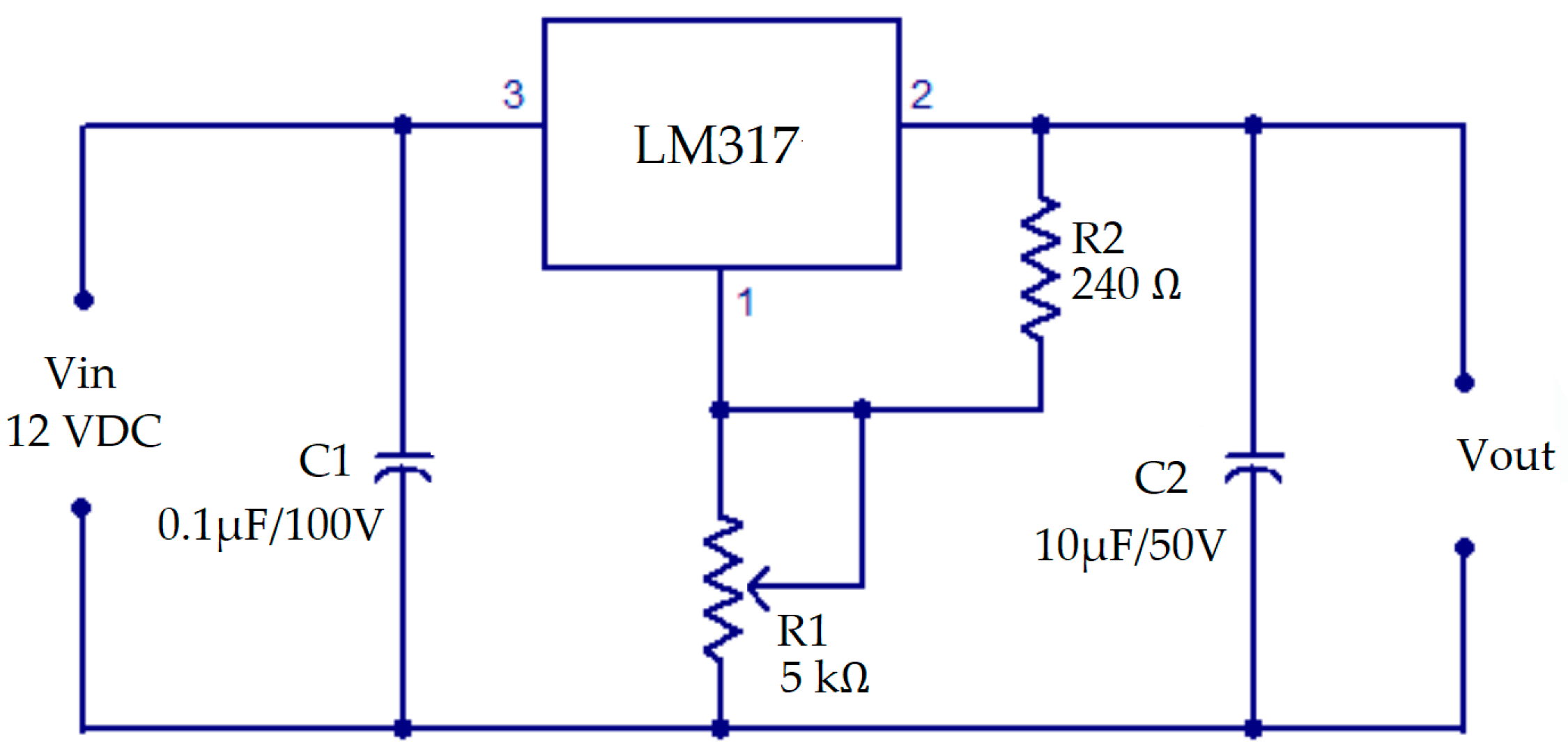
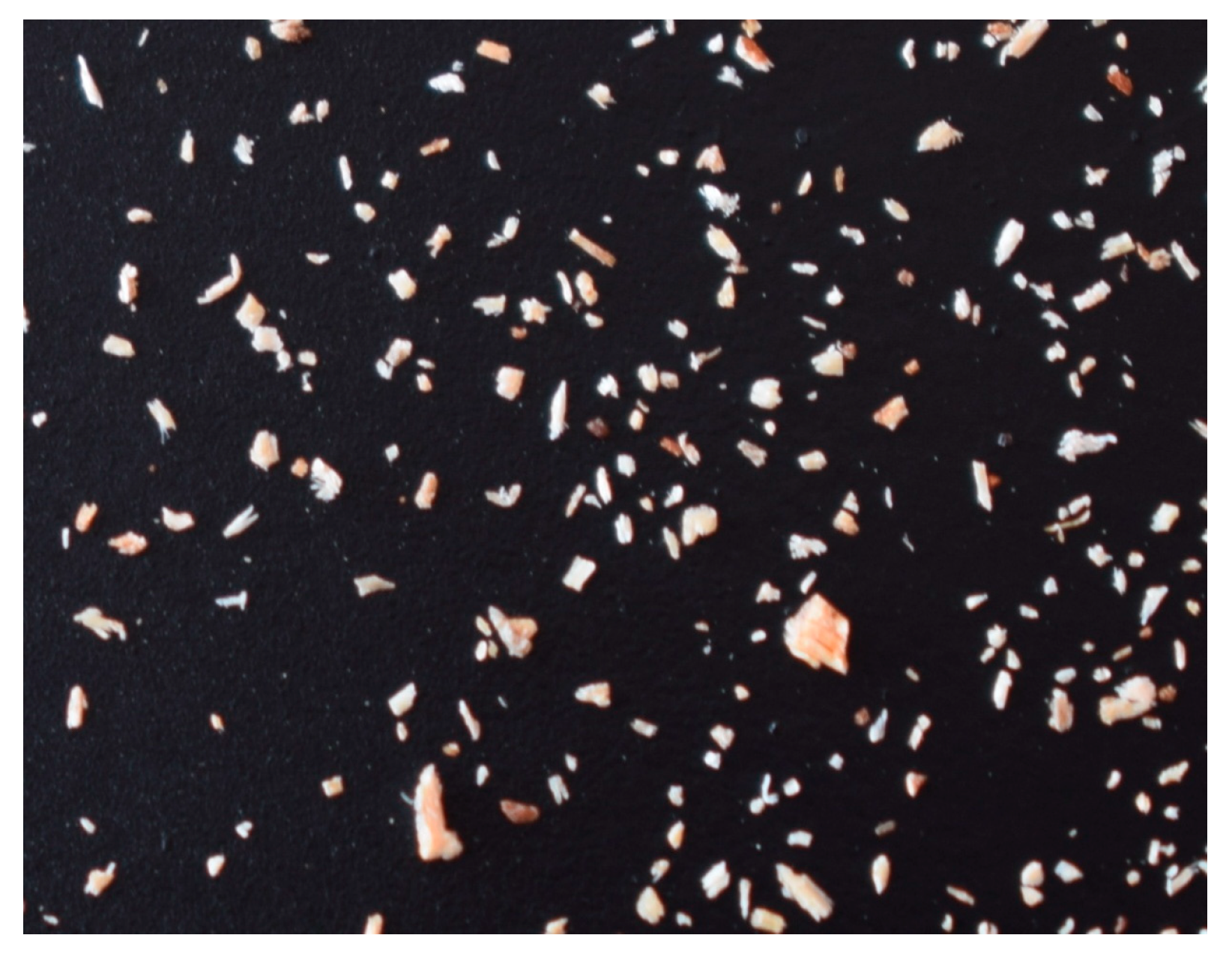
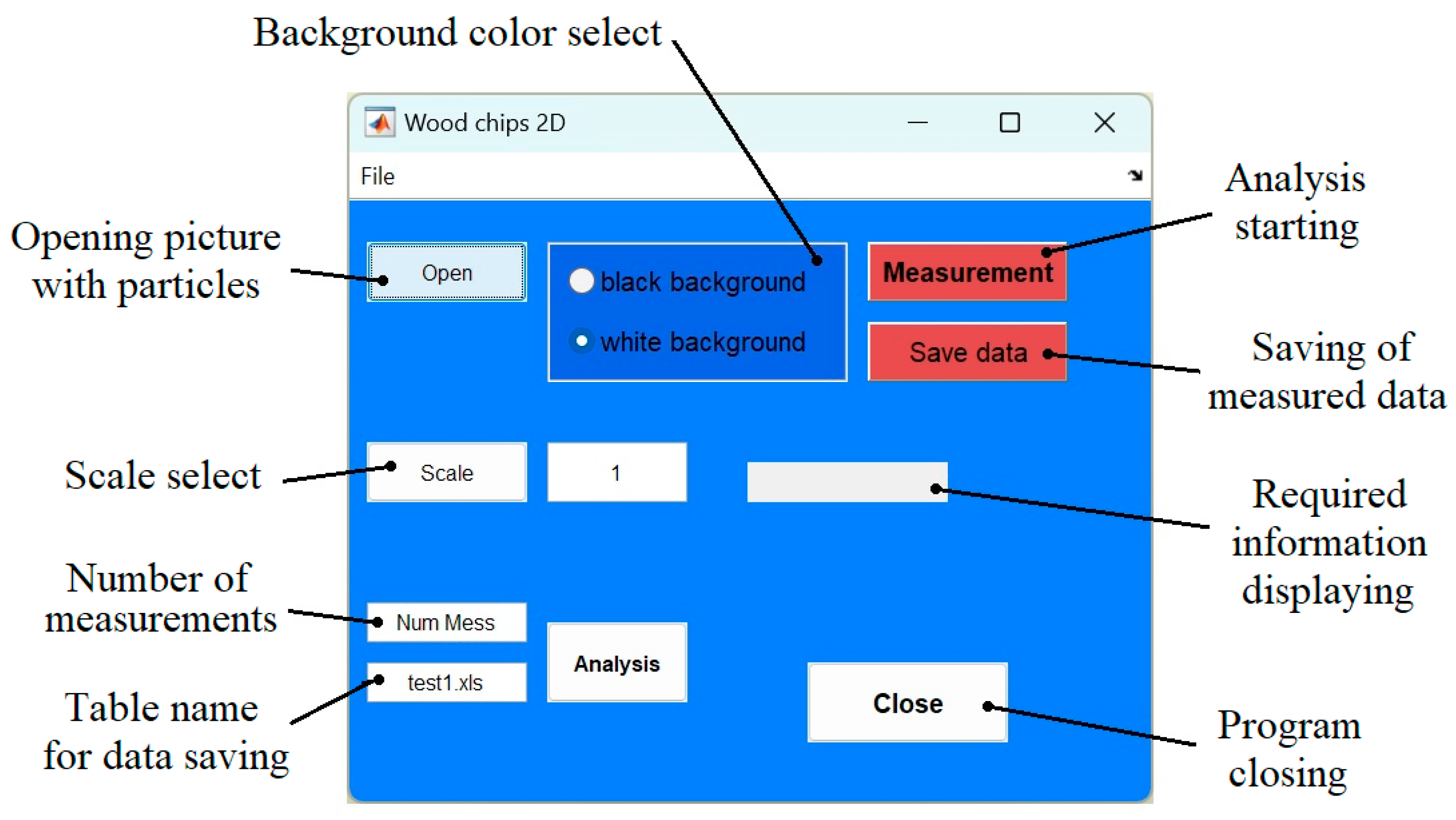
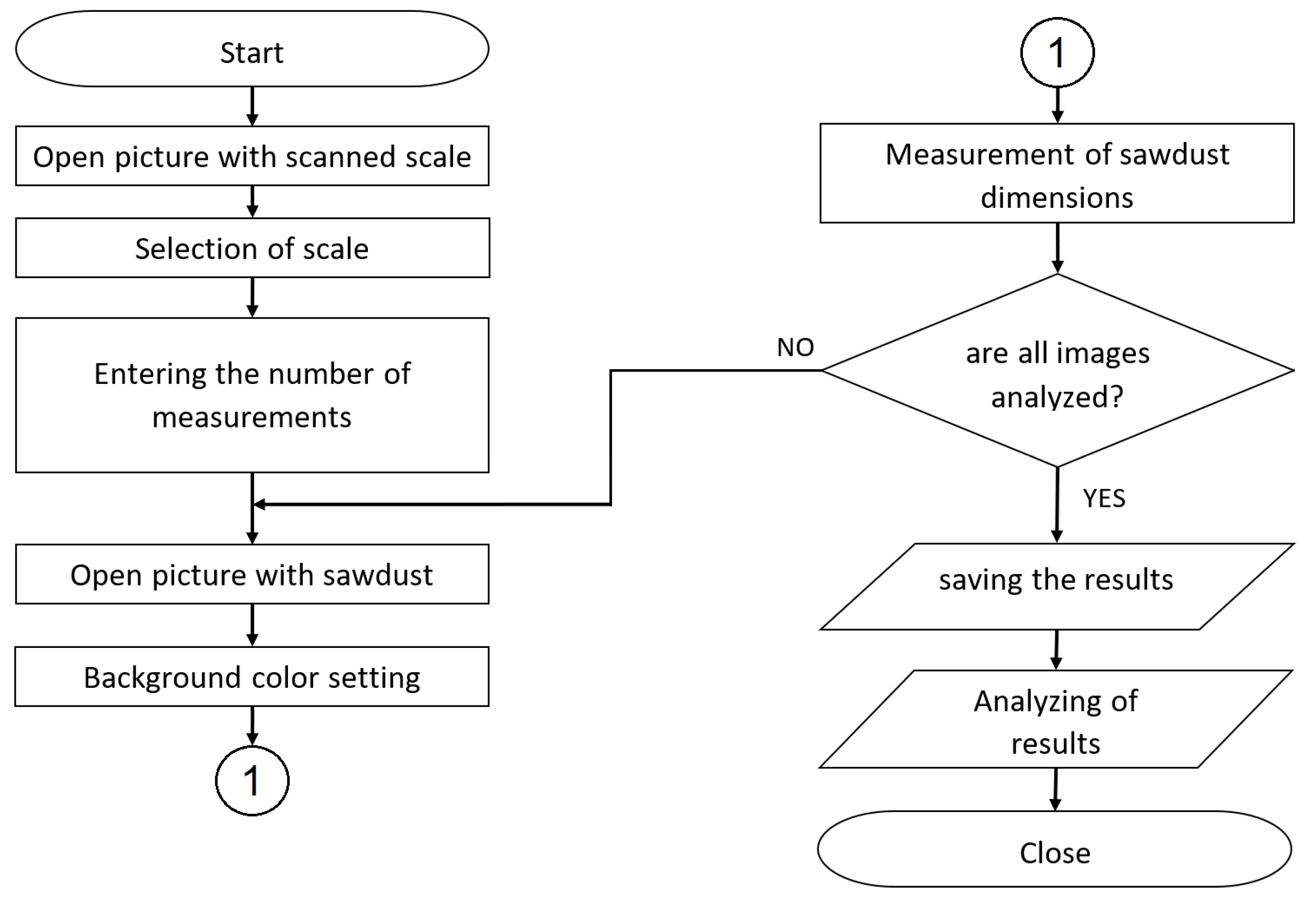
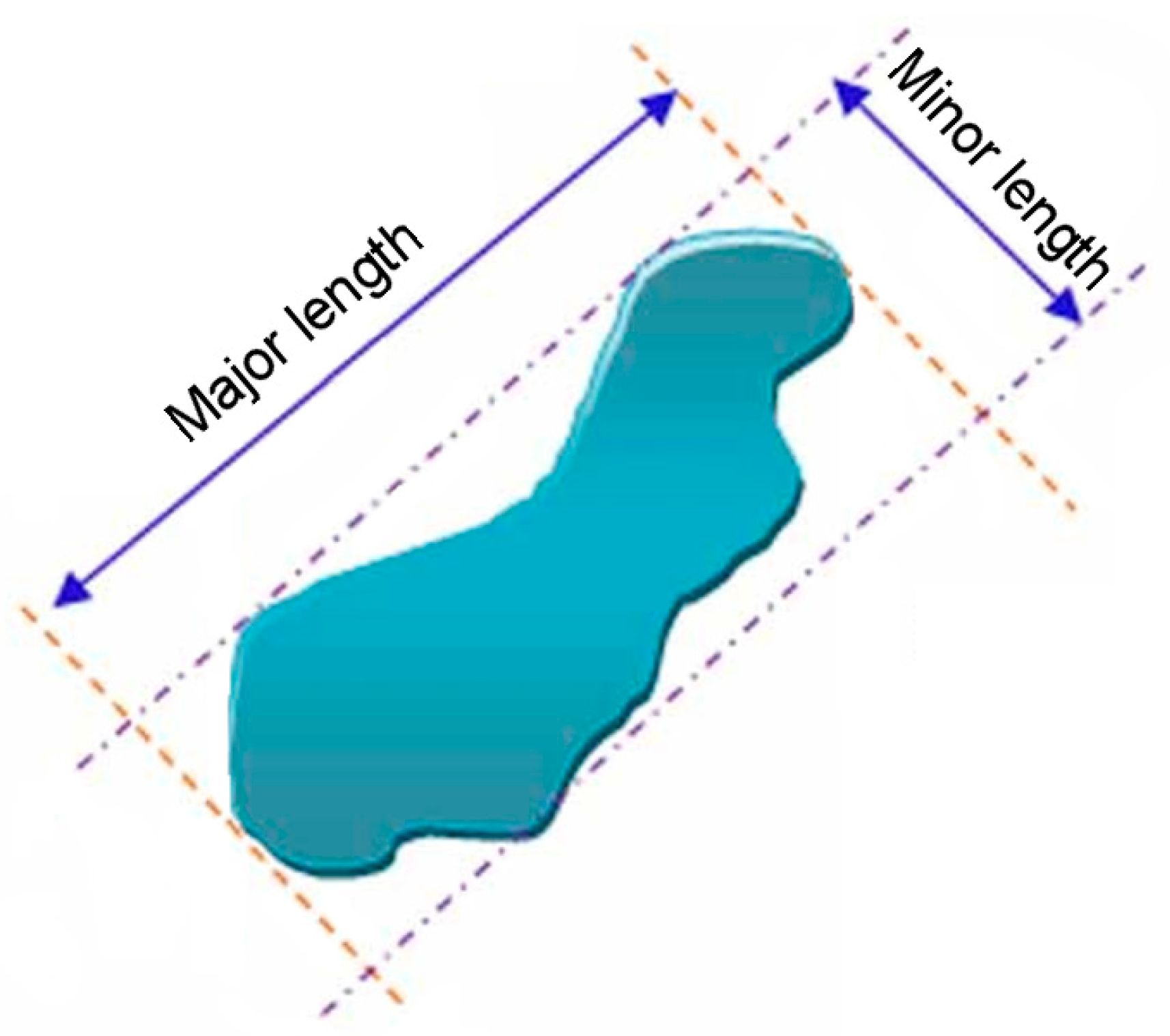
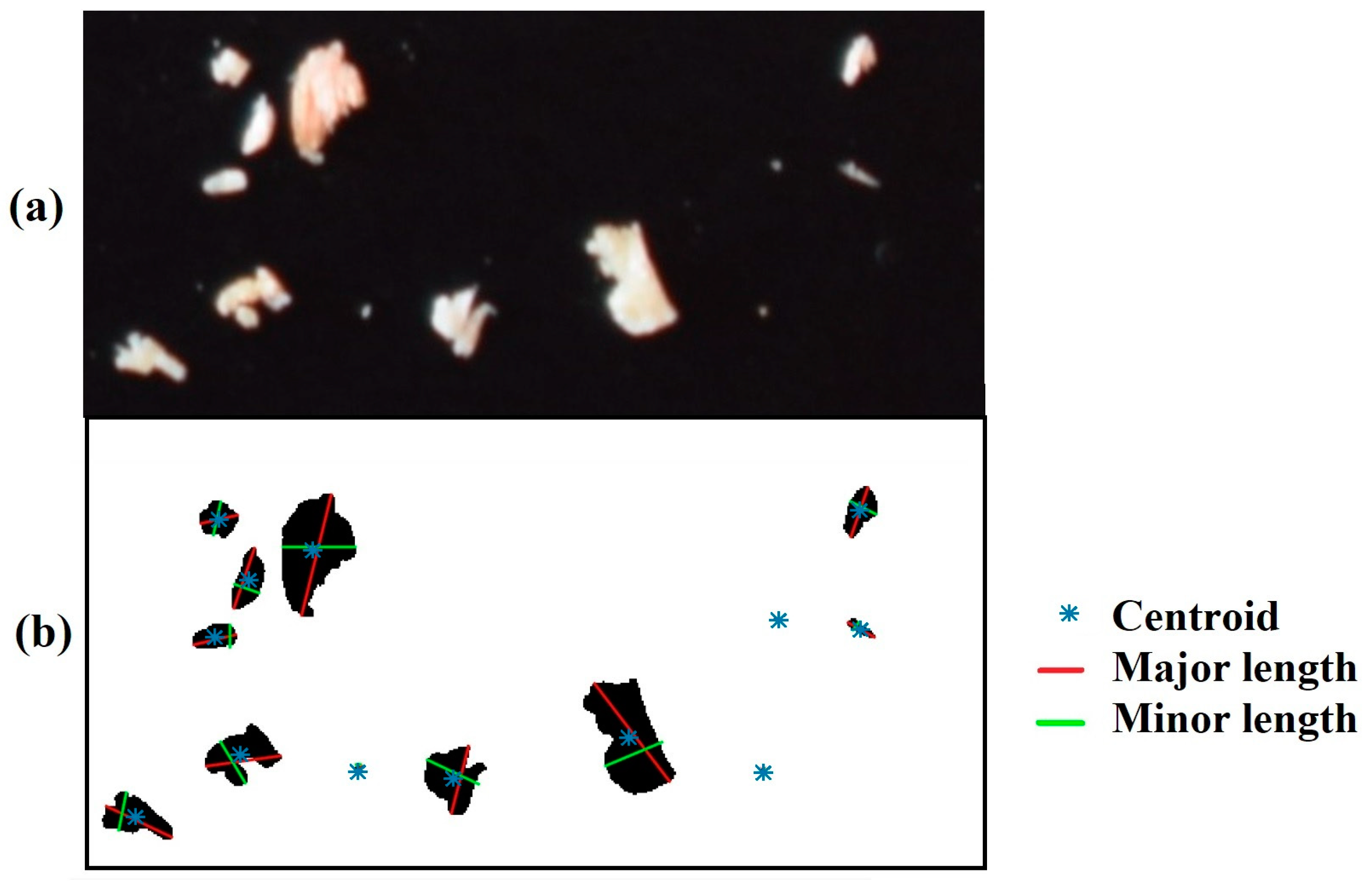

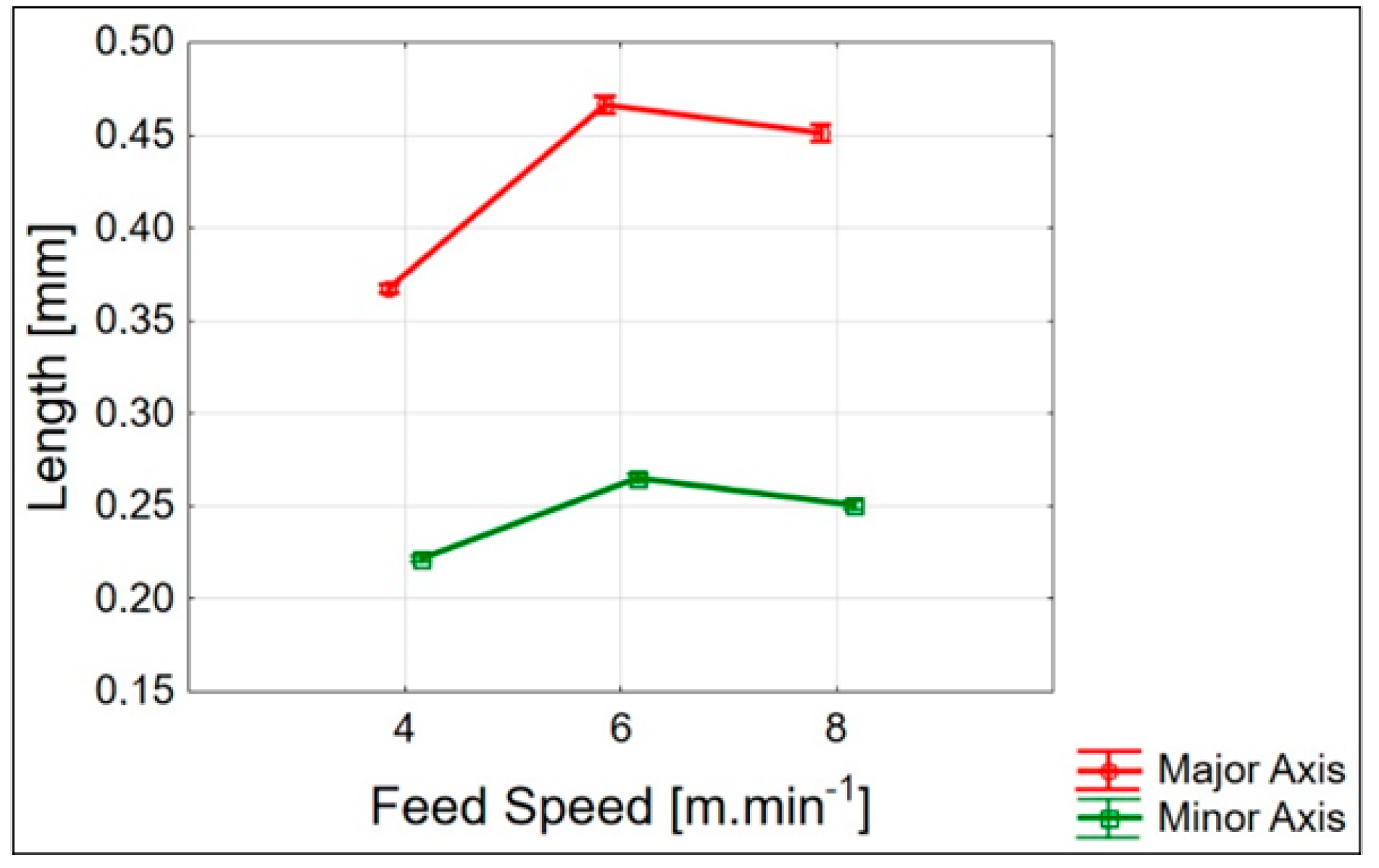
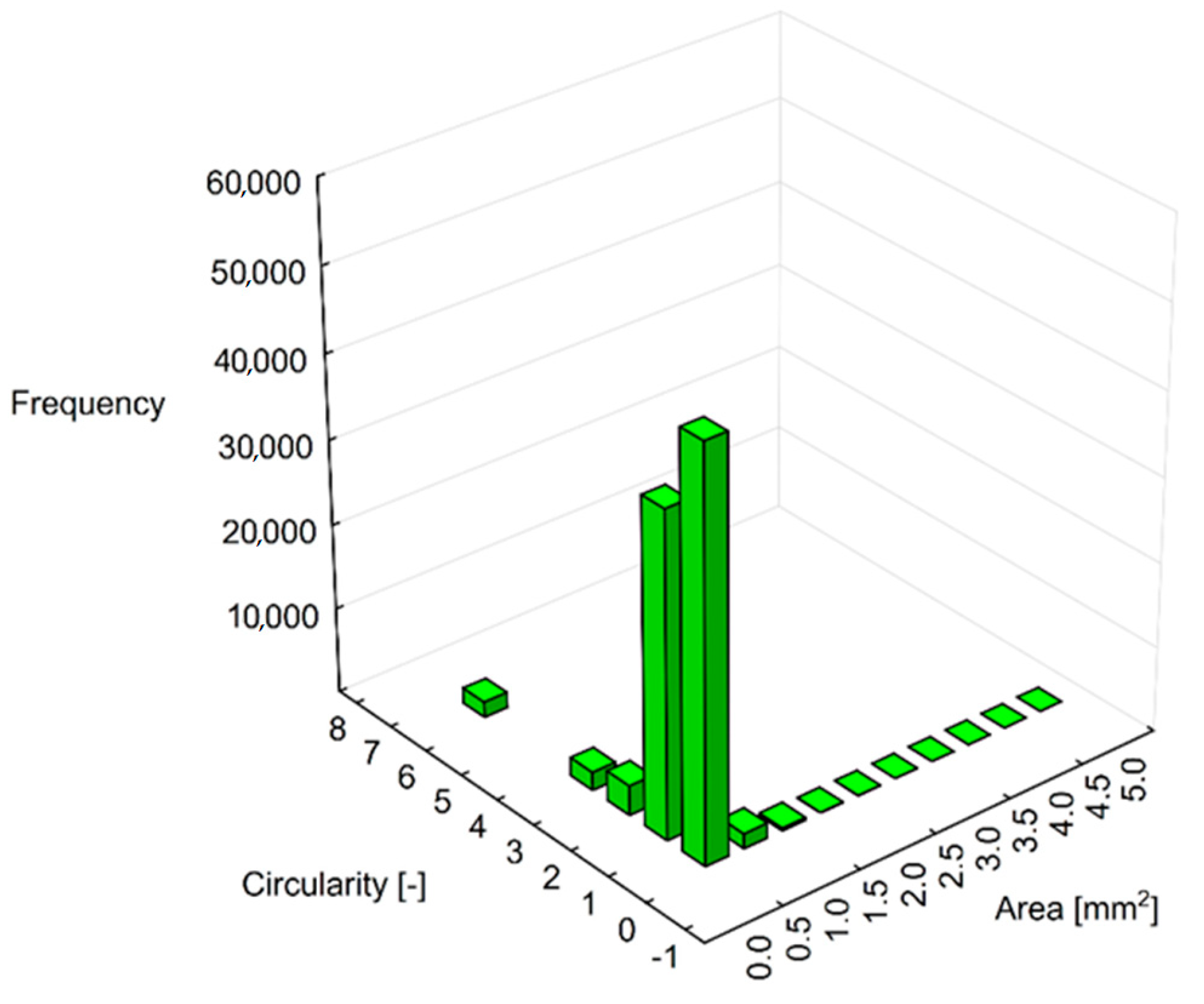

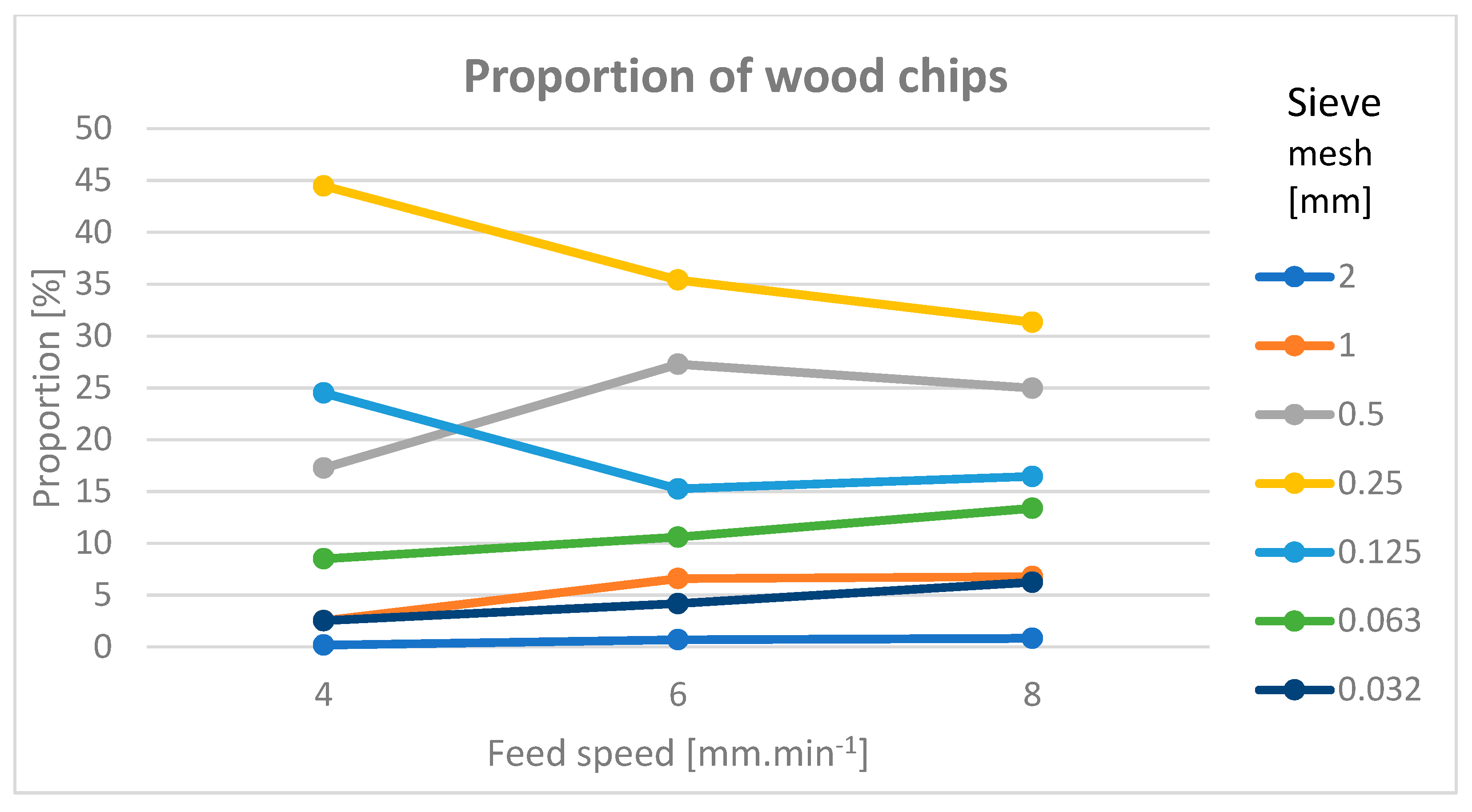
| Parameter | Range |
|---|---|
| Userful desktop | 3050 × 1300 × 300 mm |
| X-axis speed | 0–70 m·min−1 |
| Y-axis speed | 0–40 m·min−1 |
| Z-axis speed | 0–15 m·min−1 |
| Vector rate | 0–83 m·min−1 |
| Revolutions | 600–24,000 rpm |
| Power | 11 kW |
| Maximum tool diameter | D = 160 mm |
| Maximum tool length | L = 180 mm |
| Name | Working Diameter D (mm) | Working Length L (mm) | Diameter of Chucking Shank S (mm) | Number of Cutting Blades | Material of Cutting Edges |
|---|---|---|---|---|---|
| Router Cutter Economic Z2 + 1 | 18 | 26 | 20 | 2 + 1 HW | Diamond |
| Parameter | Value |
|---|---|
| ISO sensitivity | 100 |
| Shutter speed | 6.0 s |
| Aperture | f/5.6 |
| Focal length | 55 mm |
| Effective pixels | 24.2 Mpix |
| Sensor format | APS-C |
| Image sensor type | CMOS |
| Feed Speed | {1} | {2} | {3} |
|---|---|---|---|
| 4 m·min−1 | 0.000011 | 0.000009 | |
| 6 m·min−1 | 0.000011 | 0.011701 | |
| 8 m·min−1 | 0.000009 | 0.011701 |
Disclaimer/Publisher’s Note: The statements, opinions and data contained in all publications are solely those of the individual author(s) and contributor(s) and not of MDPI and/or the editor(s). MDPI and/or the editor(s) disclaim responsibility for any injury to people or property resulting from any ideas, methods, instructions or products referred to in the content. |
© 2023 by the authors. Licensee MDPI, Basel, Switzerland. This article is an open access article distributed under the terms and conditions of the Creative Commons Attribution (CC BY) license (https://creativecommons.org/licenses/by/4.0/).
Share and Cite
Koleda, P.; Koleda, P.; Hrčková, M.; Júda, M.; Hortobágyi, Á. Experimental Granulometric Characterization of Wood Particles from CNC Machining of Chipboard. Appl. Sci. 2023, 13, 5484. https://doi.org/10.3390/app13095484
Koleda P, Koleda P, Hrčková M, Júda M, Hortobágyi Á. Experimental Granulometric Characterization of Wood Particles from CNC Machining of Chipboard. Applied Sciences. 2023; 13(9):5484. https://doi.org/10.3390/app13095484
Chicago/Turabian StyleKoleda, Pavol, Peter Koleda, Mária Hrčková, Martin Júda, and Áron Hortobágyi. 2023. "Experimental Granulometric Characterization of Wood Particles from CNC Machining of Chipboard" Applied Sciences 13, no. 9: 5484. https://doi.org/10.3390/app13095484
APA StyleKoleda, P., Koleda, P., Hrčková, M., Júda, M., & Hortobágyi, Á. (2023). Experimental Granulometric Characterization of Wood Particles from CNC Machining of Chipboard. Applied Sciences, 13(9), 5484. https://doi.org/10.3390/app13095484







